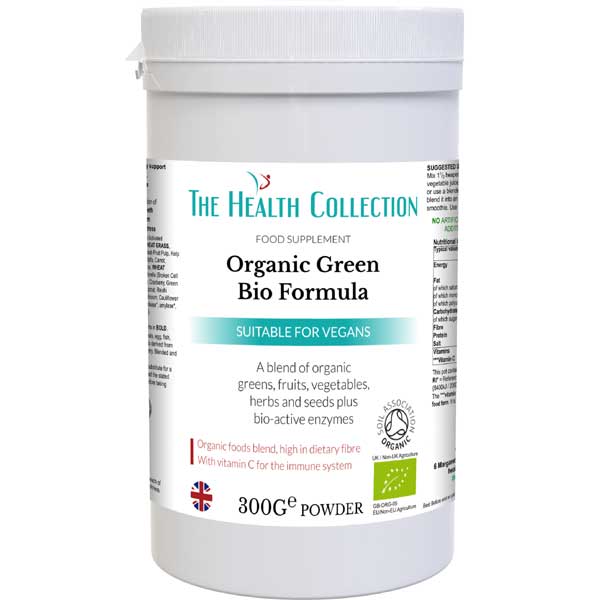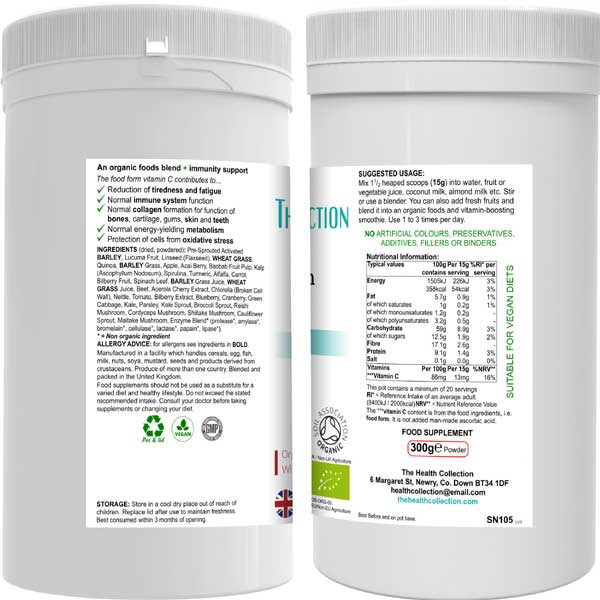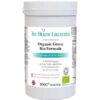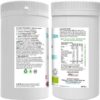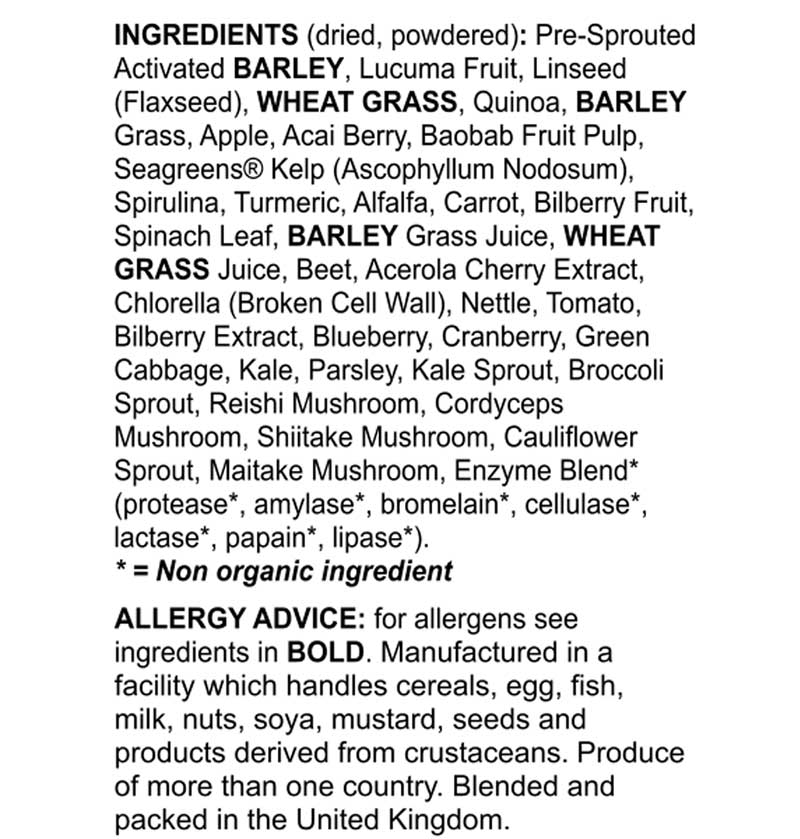Organic Green Bio Superfood Powder is much more than your standard superfood green powder. Our specialist blend contains over 35 nutrient rich organic ingredients including barley grass, fruits, berries, vegetables, mushrooms, quinoa, herbs, seeds and bio active enzymes.
Our tasty blend is designed to help you easily reach your daily recommended vegetable intake and give you optimum immune, digestive and energy metabolism support, as well as a host of other health benefits.
THIS PRODUCT CONTAINS GLUTEN
Why buy our Organic Green Bio Formula?
- 100% organic nutrient rich raw ingredients
- Suitable for vegetarians & vegans
- Dairy free
- Not suitable for coeliacs
- Naturally alkalises your body
- Organic standard Soil Association certified
- Suitable for men and women,
- Manufactured in the UK.
What’s in Organic Green Bio Formula?
This blend contains the following ingredients, in concentrated powder form:
Green foods:
Pre-sprouted activated barley, wheat grass, quinoa, barley grass, alfalfa, Ascophyllum (kelp), spirulina, barley grass juice, wheat grass juice, chlorella and nettle.
Fruits and berries:
Apple, acai berry, bilberry fruit, baobab fruit pulp, lucuma fruit, Acerola cherry, bilberry extract, blueberry and cranberry.
Vegetables:
Beet, carrot, tomato, kale, parsley, green cabbage and spinach leaf.
Seeds and herbs:
Linseed / flaxseed and turmeric.
Sprouts:
Kale sprout, broccoli sprout and cauliflower sprout.
Mushrooms:
Reishi mushroom, cordyceps mushroom, shiitake mushroom and maitake mushroom.
Plus bio-active enzymes:
Protease, amylase, bromelain, cellulase, lactase, papain and lipase.
And vitamin C:
From ascorbic acid, providing 16% nutrient reference value.
According to the European Food Safety Authority (EFSA)
- Vitamin C contributes to maintaining the normal function of the immune system. It also contributes to normal collagen formation for the normal function of blood vessels, bones, cartilage, gums, skin and teeth, normal energy-yielding metabolism, normal functioning of the nervous system, normal psychological function, protection of cells from oxidative stress, the reduction of tiredness and fatigue, the regeneration of the reduced form of vitamin E and increases iron absorption.
- Barley grain fibre contributes to an increase in faecal bulk for a healthy digestive system and optimal metabolism and energy production.
Pre Sprouted Activated barley & Barley Grass: A green grass with naturally high levels of vitamins and minerals including potassium, calcium, magnesium, iron, copper, phosphorus, manganese, zinc, beta carotene, B1, B2, B6, C, folic acid and pantothenic acid. Contains 30 times more vitamin B1 and 11 times the amount of calcium than there is in cow’s milk, 6.5 times as much carotene and nearly 5 times the iron of spinach, 7 times the vitamin C in oranges, 4 times the vitamin B1 in whole wheat flour as well as 80 micrograms of vitamin B12 per 100 grams of dried barley plant juice and very high in organic sodium. Barley grass, at the time it is harvested to make juice, is about 45 percent protein. It has almost twice as much protein as an equivalent amount of wheat germ and about five times the minerals which accompany animal protein, in addition the protein in barley grass doesn’t come burdened with fat. Enzymes (barley grass is believed to contain up to 1,000 of them) are the necessary regulators of the body, necessary for proper cell function. One of the highest natural levels of enzyme SOD (superoxide dismutase), which is a powerful antioxidant that protects the cells against toxic free radicals. Contains the green pigment, chlorophyll – a natural detoxifier that rids the intestines of stored toxins. Pre-sprouted barley utilises the latest patented scientific food technology, whereby all the natural active enzymes and nutrients in the barley grain are captured just prior to sprouting (the most nutrient and enzyme rich stage). Pre sprouting also provides access to a wide variety of vitamins, minerals, amino acids and essential fatty acids.
Wheat Grass: A high nutrient to calorie ratio that makes it a complete food in itself (a superfood). 1 pound of fresh wheat grass is equivalent in nutritional value to 23 pounds of fresh garden vegetables. One of the main reasons for the excellent nutritional value of wheat grass is the presence of chlorophyll – a green pigment (and powerful phyto-chemical) formed in plants in the presence of sunlight, by the process of photosynthesis. Wheat grass contains up to 70% chlorophyll, which contains vitamins (including A, all the B vitamins, C, E and K) and minerals (iron, phosphate, boron, copper, selenium, calcium, magnesium, potassium, chromium, manganese, phosphorous, silicon and zinc). Wheat grass is also a very good source of dietary fibre and is a complete plant protein (very nutrient dense), it doesn’t contain the high levels of saturated fat, cholesterol and calories usually found in animal / dairy sources. Also a source of natural exogenous enzymes not made naturally in the human digestive system (oxidase, lipase, protease, amylase, catalase, peroxidase, tranhydrodinase and superoxydismutase). These enzymes support efficient digestion, a complex process which involves literally hundreds of thousands of specific enzymes.
Quinoa: This grain has a high protein content and has been added to our Green Bio Formula to support the amino acid profile of the presprouted barley and wheatgrass.
Alfalfa: Rich in vitamins and minerals such as pro-Vitamin A (B-carotene), B6, C, D, E, K, and P, alfalfa yields 10 times more mineral value than an average grain. It also contains chlorophyll and contains 8 essential enzymes.
Seagreens® Ascophyllum (kelp): A seaweed of the northern Atlantic Ocean also known as kelp. Seagreens® Ascophyllum nodosum is sourced from the Scottish Outer Hebrides and is the highest of Seagreens’® species in terms of iodine levels – typically 700mcg iodine per 1g. Also rich in both macro nutrients (nitrogen, phosphorus, potassium, calcium, magnesium, sulphur) and micro nutrients (manganese, copper, iron, zinc). It is also host to cytokinins, auxin-like gibberellins, betaines, mannitol, organic acids, polysaccharides, amino acids, antioxidants and proteins, which are all highly beneficial.
Spirulina: Spirulina is a blue green microalgae and contains between 55 and 70% protein (more than beef, chicken, and soybeans), 8 essential and 10 non essential amino acids, as well as gamma linolenic acid (GLA), beta-carotene, linoleic acid, arachidonic acid, vitamin K, pantothenic acid, magnesium, potassium, thiamin, riboflavin, niacin, iron, copper, manganese, nucleic acids RNA and DNA, chlorophyll and phycocyanin.
Chlorella: An edible, single cell marine algae (a sea-moss or sea lettuce), chlorella contains chlorophyll, vitamin B12, beta-carotene, polyunsaturated fatty acids and 19 amino acids (including the 8 essential amino acids). It is also a source of calcium, iron, selenium and zinc.
Nettle: A source of chlorophyll, vitamins (including vitamin C), serotonin, histamine, acetyl-choline, minerals (including iron), calcium and silica.
Acai Berry: A superfruit berry naturally rich in minerals, healthy fats, vitamins and other nutrients, including: vitamin C, vitamin A, B vitamins (niacin, vitamin B6 and riboflavin), vitamin K, dietary fibre, omega fatty acids (omega-6 (linoleic acid) and omega-9 (oleic acid)), protein, copper, iron, zinc, magnesium, manganese, potassium, antioxidants (resveratrol, cyanidin-3-galactoside, ferulic acid, delphinidin and petunidin), polyphenols and flavonoids.
Bilberry: Closely related to blueberries, bilberries contain diverse anthocyanins, including delphinidin and cyanidin glycosides., and are often associated with improvement of night vision.
Baobab Fruit: Famed for its incredible nutritional properties and deserving of the name ‘superfood’. An excellent source of many vitamins and minerals, it has: five times the magnesium of avocados; four times the potassium of bananas; twice the calcium of milk; twice the antioxidants of acai berries, and more than any other fruit; ten times the vitamin C of oranges; and ten times the fibre of apples. In other words, baobab is highly nutritious and different parts of the plant supply varying amounts of protein, vitamin C, antioxidants, potassium, magnesium, iron, zinc, calcium and B vitamins. Due to the fact that it is high in dietary fibre, it has been shown to support digestive health, as well as reduce feelings of hunger which could promote weight loss. Baobab may also help slow the increase of blood sugar levels and decrease the amount of insulin needed to keep your blood sugar under control. Studies show that baobab can help to reduce inflammation and prevent oxidative damage to cells.
Lacuma: Lucuma is the fruit of the Pouteria lucuma tree, native to South America. It has a hard, green outer shell and soft, yellow flesh with a dry texture and sweet flavour. Nicknamed the “gold of the Incas,” lucuma has been used as a traditional remedy in South America for centuries. Lucuma powder provides both soluble and insoluble fibre, a variety of antioxidants (including high levels of vitamin C, polyphenols and carotenoids) and is helpful in terms of keeping blood sugar levels stable by improving insulin sensitivity and preventing blood sugar spikes after a meal or snack.
Acerola Cherry: Known as superfruits due to their excellent nutritional value and exceptionally high vitamin C content. Vitamin C is essential for the growth and repair of cells and for a strong immune system. Acerola cherries provide a naturally bio-available and powerful source of vitamin C, which is fully utilised by the body (unlike synthetic ascorbic acid, which is sold as vitamin C).
Blueberry: Contains high levels of anthocyanin antioxidants, including malvidins, delphinidins, pelargonidins, cyanidins and peonidins. They also contain the antioxidant flavonoid, quercetin. And, if you want to maximise the antioxidant benefits from blueberries, go organic! A recent study has directly compared the total antioxidant capacity of organically grown versus non-organically grown highbush blueberries (Vaccinium corymbosum L., var. Bluecrop) and found significantly higher concentrations of total phenol antioxidants and total anthocyanin antioxidants in the organic blueberries, as well as significantly higher total antioxidant capacity.
Cranberry: For many years, researchers believed that the ability of cranberries to help prevent urinary tract infections (UTIs) was partly related to the strong acidity of the cranberries. Recent research has shown that it’s not the acidity of the cranberries, but the unusual nature of their proanthocyanidins (PACs) that is related to prevention of UTIs. The special structure of these PACs (involving A-type linkages between their components) acts as a barrier to bacteria that might otherwise latch on to the urinary tract lining. In many studies, the UTI-preventing benefits of cranberries are somewhat modest and limited to women who have recurrent UTIs. But this whole area of investigation has opened the door to an understanding of other possible cranberry benefits. For example, stomach ulcers are often related to overgrowth and over-linking of one particular type of stomach bacteria (Helicobacter pylori) to the stomach lining. In much the same way as cranberries may help prevent bacterial attachment to the lining of the urinary tract, they may also help prevent attachment of bacteria to the stomach lining. There is already some preliminary evidence that cranberry may help protect us from stomach ulcer in this way. We expect to see future studies confirming this fascinating type of health benefit. Among the fruits and vegetables richest in antioxidants berries such as cranberries rank right up there at the top of the list. They have a vast array of other nutrients too, including digestion-aiding enzymes.
Beet: Beetroot is the taproot portion of the beet plant. It is one of several of the cultivated varieties of Beta vulgaris grown for their edible taproots and their leaves (called beet greens). It is a source of dietary fibre, folate (vitamin B9), manganese, potassium, iron and vitamin C. The deep red colour of beetroot results from the presence of a type of betalain pigment (betacyanins). Beetroot is also a source of betaine and inorganic nitrates. The deep red colour of beetroot results from the presence of betalain pigments (betanin, an amino acid). Also a natural source of nitrate, which is vitally important in human physiology and it modulates many of the processes that are essential to exercise performance.
Carrot: A good source of thiamin, niacin, folate and vitamin B6 (which act as co-factors to enzymes during substrate metabolism in the body), as well as manganese and a very good source of dietary fibre, carotenes, vitamin A, vitamin C, vitamin K and potassium. Carotenes are converted into vitamin A in the liver cells. Beta-carotene is the major carotene present in these roots, a powerful antioxidant and a nutrient involved in all of the functions of vitamin A, such as maintaining good eye health, reproduction (sperm production), maintenance of epithelial integrity, growth and development. Carrots are also rich in the poly-acetylene antioxidant, falcarinol.
Tomato: Recognised for their high antioxidant content, including a rich concentration of lycopene. Researchers have recently found an important connection between lycopene, its antioxidant properties, and bone health. A study was designed in which tomato and other dietary sources of lycopene were removed from the diets of post-menopausal women for a period of 4 weeks, to see what effect lycopene restriction would have on bone health. At the end of 4 weeks, women in the study started to show increased signs of oxidative stress in their bones and unwanted changes in their bone tissue. The study investigators concluded that removal of lycopene-containing foods (including tomatoes) from the diet was likely to put women at increased risk of osteoporosis. They also argued for the importance of tomatoes and other lycopene-containing foods in the diet. Tomatoes also contain vitamin C, potassium, folate, vitamin K, vitamin E (Alpha Tocopherol), thiamin, niacin, vitamin B6, magnesium, phosphorus, copper, dietary fibre, vitamin A and manganese.
Kale: A lutein rich food, a carotenoid nutrient. Among the carotenoids, lutein is perhaps best known for its supportive role in eye health, and in particular, for its ability to protect different parts of the eye from potential damage by light or oxygen. A recent study on African-American women has shown decreased likelihood of glaucoma (an eye problem usually caused by increased pressure within the eye) when dietary intake of kale reaches higher intake levels. In this case, “higher intake levels” were defined as any levels exceeding at least one half-cup serving per week. Another recent study analysed the combination of kale with lentils and found this food combination to be especially complementary in providing us with nutrient-richness. Interestingly, this study focused on two areas of nutrition: mineral nourishment and prebiotic nutrients, nutrients that support the growth of desirable bacteria within our digestive tract. These nutrients often involve short chains of simple sugars called “oligosaccharides.” Glucooligosaccharides, fructooligosaccharides, and xylooligosaccharides are well-studied examples of oligosaccharides.
Parsley: Contains vitamins A, C, E, bioflavonoids, iron, folic acid, volatile oils, coumarins, flavonoids, chlorophyll, manganese, calcium and potassium.
Green Cabbage: Studies show green cabbage to help in the prevention of type 2 diabetes in a recent study of over 57,000 adults in the country of Denmark? In this very large-scale study, adults who closely followed the Healthy Nordik Food Index were found to have the lowest incidence of type 2 diabetes. Importantly, this key health benefit was linked to six food intake categories: (1) fish, (2) rye bread, (3) oatmeal, (4) apples and pears, (5) root vegetables, and (6) cabbage. Researchers have now identified nearly 20 different flavonoids and 15 different phenols in cabbage, all of which have demonstrated antioxidant activity.
Spinach Leaf: Contains vitamins A, B2, B6, B9 C, E and K, lutein, magnesium, manganese, folate, betaine, iron, calcium, potassium, folic acid, copper, protein, phosphorus, zinc, niacin, selenium and Omega 3 oils. More recently, opioid peptides called rubiscolins have also been found in spinach.
Flaxseed: Most plant foods contain at least small amounts of phytonutrients called lignans. Lignans are unique fibre related polyphenols that provide us with antioxidant benefits, fibre nlike benefits, and also act as phytoestrogens. Among all commonly eaten foods, researchers now rank flaxseeds as the number 1 source of lignans in the human diet. Flaxseeds contain about 7 times as many lignans as the closest runner-up food (sesame seeds). They contain about 338 times as many lignans as sunflower seeds, 475 times as many as cashew nuts, and 3,200 times as many lignans as peanuts. When we think about antioxidant-rich foods, the first foods that come to mind are typically vegetables and fruits. Of course, foods in both of these food groups can be outstanding sources of antioxidants! Yet according to recent research, flaxseeds also belong high up on our list of antioxidant-rich foods. When flaxseeds are compared with other commonly eaten foods in terms of their total polyphenol content (polyphenols are one very important group of antioxidants), flaxseeds rank 9th among 100 commonly eaten foods. The antioxidant benefits of flaxseeds have long been associated with prevention of cardiovascular diseases and have recently also been tied to decreased insulin resistance.
Turmeric: A natural anti inflammatory spice which contains dietary fibre, volatile oil, vitamins (such as vitamin C and vitamin B6), minerals (such as potassium, calcium, iron and magnesium) and the yellow pigment, curcumin.
Kale Sprout: Packed with vitamin C and notable for their high levels of glucosinolates and metabolites isothiocyanates.
Broccoli Sprout: A source of glucoraphanin, which creates sulforaphane when chewed or swallowed, a compound which accelerates the body’s ability to detoxify from various pollutants. As with kale sprouts, these sprouts are also notable for their high levels of glucosinolates, and more importantly, their metabolites isothiocyanates.
Reishi Mushroom: With the Japanese name Reishi or Mannetake (10,000 year mushroom), the Chinese name Ling Zhi (spirit mushroom – mushroom of spritual potency), this mushroom is also referred to as the ‘mushroom of immortality’ of Chinese legend because it has been linked to anti-aging and longevity, as well as detoxification, anti-inflammatory actions, energy boosting, immunity and more. Reishi is rich in active polysaccharides, as well as triterpenoid compounds (primarily ganoderic and lucidenic acids).
Cordyceps Mushroom: Known to support respiratory health, increase oxygen uptake, boost heart health, detoxify the body, slow the aging process, increase energy and improve the immune system.
Shiitake Mushroom: Lentinus edodes are widely eaten as a food and used in herbal preparations in the Far East and South America. They have more recently grown in popularity in the West and contain triterpenes, polysaccharides and lentinan.
Cauliflower Sprout: Recent studies suggest that cauliflower is an excellent source of natural antioxidants due to its high levels of various phytochemicals. Also a rich source of essential vitamins, carotenoids, fibre soluble sugars, minerals, and phenolic compounds.
Maitake Mushroom: Traditionally used as medicine in Japan for centuries to promote longevity. Maitakes contain a polysaccharide (many sugar molecules joined together to form one large molecule) called beta glucan and are associate with health benefits including immune booster, blood sugar management and heart helper.
Enzyme Blend: Our Organic Green Bio Formula contains the following naturally occurring enzymes;
- Proteases are digestive enzymes that break proteins down into amino acids.
- Amylase is a digestive enzyme essential for our digestion of carbohydrates, as amylase breaks down starches into sugars.
- Bromelain is a protein-digesting enzyme mixture derived from the stem, fruit, and juice of the pineapple plant.
- Cellulase is any of several enzymes produced chiefly by fungi, bacteria, and protozoans that catalyze cellulolysis, the decomposition of cellulose and of some related polysaccharides.
- Lactase is a type of enzyme that breaks down the sugar, lactose, found in dairy products. Papain is a proteolytic enzyme extracted from the raw fruit of the papaya plant.
- Proteolytic enzymes help break proteins down into smaller protein fragments called peptides and amino acids.
- Lipase is the enzyme responsible for the breakdown of fats that we consume. Specifically, lipase breaks fats into fatty acids and glycerol (simple sugar alcohol).

